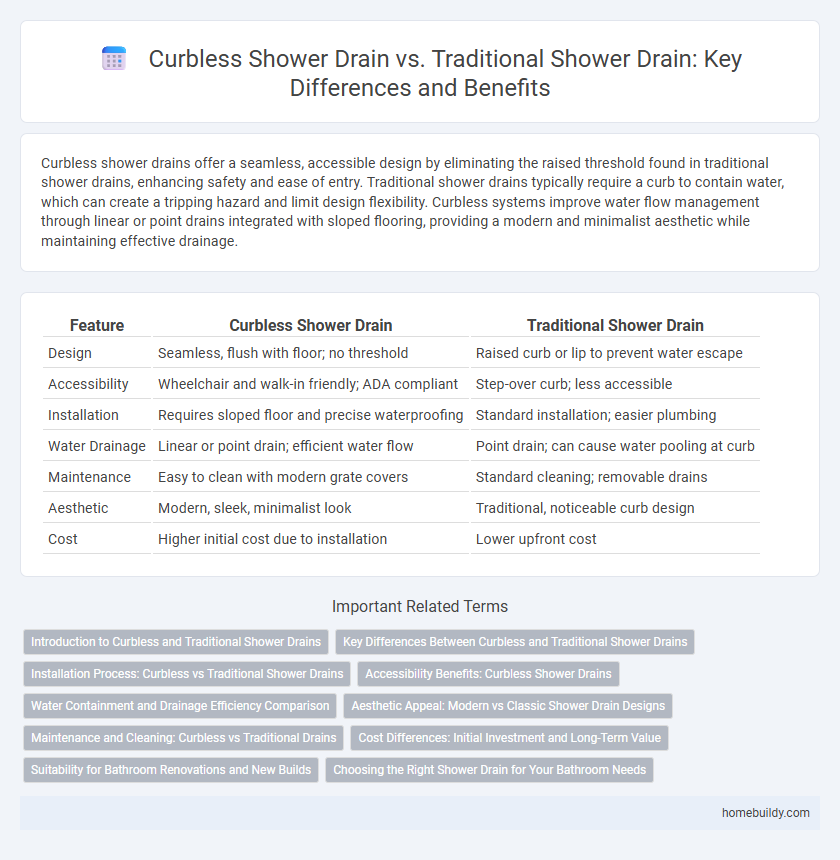Curbless shower drains offer a seamless, accessible design by eliminating the raised threshold found in traditional shower drains, enhancing safety and ease of entry. Traditional shower drains typically require a curb to contain water, which can create a tripping hazard and limit design flexibility. Curbless systems improve water flow management through linear or point drains integrated with sloped flooring, providing a modern and minimalist aesthetic while maintaining effective drainage.
Table of Comparison
| Feature | Curbless Shower Drain | Traditional Shower Drain |
|---|---|---|
| Design | Seamless, flush with floor; no threshold | Raised curb or lip to prevent water escape |
| Accessibility | Wheelchair and walk-in friendly; ADA compliant | Step-over curb; less accessible |
| Installation | Requires sloped floor and precise waterproofing | Standard installation; easier plumbing |
| Water Drainage | Linear or point drain; efficient water flow | Point drain; can cause water pooling at curb |
| Maintenance | Easy to clean with modern grate covers | Standard cleaning; removable drains |
| Aesthetic | Modern, sleek, minimalist look | Traditional, noticeable curb design |
| Cost | Higher initial cost due to installation | Lower upfront cost |
Introduction to Curbless and Traditional Shower Drains
Curbless shower drains eliminate the need for a raised threshold, enabling a seamless, accessible shower floor that enhances safety and aesthetic appeal. Traditional shower drains typically require a curbed edge to direct water flow toward the drain, which can create a step that may be hazardous for users with mobility challenges. Modern curbless designs use linear or trench drains combined with precise floor slopes to ensure efficient water drainage without barriers.
Key Differences Between Curbless and Traditional Shower Drains
Curbless shower drains feature a seamless, level floor design that eliminates the need for a raised threshold, promoting accessibility and modern aesthetics. Traditional shower drains require a curb to contain water, which can limit entry options and pose a tripping hazard. The curbless option enhances water drainage efficiency with linear or trench drains, while traditional drains typically use a center drain that may require more floor slope for proper drainage.
Installation Process: Curbless vs Traditional Shower Drains
Curbless shower drains require a precise slope in the subfloor to direct water efficiently, often involving complex waterproofing and custom framing during installation. Traditional shower drains typically install into pre-framed curbs with standard drainage connections, making the process more straightforward and faster. Proper planning for curbless drains is essential to prevent water leakage and ensure seamless integration with the bathroom floor.
Accessibility Benefits: Curbless Shower Drains
Curbless shower drains significantly enhance accessibility by eliminating the step-over threshold found in traditional shower drains, reducing trip hazards and making showers safer for people with mobility challenges or disabilities. These drains facilitate smooth, seamless entry for wheelchairs and walkers, improving independence in bathroom use. Their design also simplifies cleaning and maintenance, promoting better hygiene and convenience.
Water Containment and Drainage Efficiency Comparison
Curbless shower drains offer superior water containment by enabling a seamless, barrier-free floor that directs water efficiently toward linear or point drains, reducing the risk of water pooling and leakage. Traditional shower drains usually rely on a raised curb and center drain system, which can trap water and require precise sloping to prevent overflow. In terms of drainage efficiency, curbless designs facilitate faster water evacuation due to optimized floor gradients and multiple drainage points, enhancing overall bathroom hygiene and safety.
Aesthetic Appeal: Modern vs Classic Shower Drain Designs
Curbless shower drains feature sleek, minimalist designs that seamlessly integrate with the shower floor, enhancing the bathroom's modern aesthetic and creating a clean, open space. Traditional shower drains typically have a raised curb and visible grate, reflecting classic styling that emphasizes functionality but can interrupt the visual flow of the shower area. Homeowners seeking a contemporary, spa-like atmosphere often prefer curbless drains for their unobtrusive look and ability to complement modern bathroom designs.
Maintenance and Cleaning: Curbless vs Traditional Drains
Curbless shower drains feature linear or trench designs that allow for easier access and quicker cleaning, minimizing the buildup of soap scum and hair clogs compared to traditional center-point drains. Traditional shower drains often require regular removal of grates and manual extraction of debris, increasing maintenance time and risk of blockages. The smooth, accessible surface in curbless drains supports better water flow and reduces mold and mildew growth, improving overall hygiene and longevity.
Cost Differences: Initial Investment and Long-Term Value
Curbless shower drains typically require a higher initial investment due to complex waterproofing and floor slope adjustments, while traditional shower drains are more cost-effective upfront with standard installation processes. Over time, curbless drains offer long-term value by improving accessibility and reducing maintenance costs associated with water pooling and mold growth. Traditional drains may incur additional expenses for repairs and accessibility modifications, potentially offsetting their lower initial cost.
Suitability for Bathroom Renovations and New Builds
Curbless shower drains offer seamless integration with modern bathroom renovations and new builds by providing a sleek, barrier-free design that enhances accessibility and aesthetic appeal. Traditional shower drains, often requiring raised curbs or thresholds, are better suited for older bathroom layouts where retrofitting may be limited by existing structural elements. For new constructions, curbless drains enable greater flexibility in floor slopes and waterproofing, promoting a streamlined, contemporary look that aligns with current design trends.
Choosing the Right Shower Drain for Your Bathroom Needs
Curbless shower drains offer a seamless, barrier-free design that enhances accessibility and modern aesthetics, making them ideal for universal bathrooms or wet-room styles. Traditional shower drains, typically installed with a raised curb, provide clear water containment and are often easier to retrofit in existing bathrooms with standard layouts. Selecting the right shower drain depends on drainage efficiency, bathroom design, user mobility needs, and installation complexity, ensuring optimal functionality and style.
Curbless shower drain vs traditional shower drain Infographic

 homebuildy.com
homebuildy.com